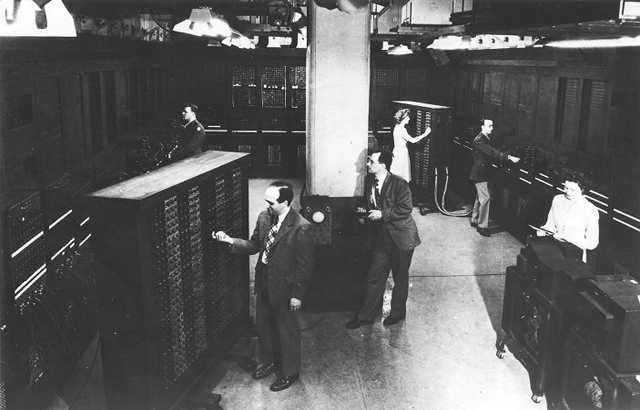In 1942, six mathematicians were selected to program a machine that would help the US army calculate complex wartime ballistics tables.
Using their combined mathematical and technical skill, these six programmers helped to create the Electronic Numerical Integrator And Computer (ENIAC) – one of the world’s first ever electronic computers.
They were also all women.
The ENIAC was hailed as a ‘giant brain’ in the contemporary media. Its capacity, with five thousand sums per second, was a thousand times faster than the calculators of the time. It is widely considered to be the grandparent of the computers that we all carry in our pockets today.
The efficiency of the machine owed a lot to its programming.
Before electronic computers existed, an applied mathematician would create models providing a general solution to a problem, which were published in large books called tables.
‘Computers’ (at the time, a job title) would then use these tables and perform arithmetic operations to generate accurate results.
The role of computer was largely considered to be a clerical job and was often assigned to women, especially during the war when many men had been enlisted.
The ENIAC was designed with hardware called function tables, which could be programmed to perform complex sequences of operations. Once the program had been figured out on paper it then had to be programmed into the ENIAC. This process took years.
Despite this, when the ENIAC was launched, the six programmers weren’t given any credit for their success. Kathleen McNulty, Frances Bilas, Betty Jean Jennings, Elizabeth Snyder, Ruth Lichterman and Marlyn Wescoff were not even invited to the launch party.
Remembering the female pioneers of computing

Their story was uncovered in the mid-1980s, when computer science graduate Kathy Kleiman, feeling discouraged about the lack of female role models in computing, set out to research the history of women in computer programming.
In her research she discovered a famous newspaper photo of the ENIAC. Only the men in the image were captioned.
When she asked around about the women in the photograph, “I was told they were models – Refrigerator Ladies’ – posing in front of the machine to make it look good,” she explained in an interview, “but that turned out to be far from the truth”.
The dwindling presence of women in computing
In the 1980s computers started regularly appearing in American homes. At the same time, the number of women studying computer science started to drop - from 37.1% in 1984 to 18% today.
One theory of why this might be is that personal computers first came in the form of toys that were almost entirely marketed to men and boys, therefore creating a narrative that computers were for boys.
At the same time, popular public figures, like Bill Gates and Steve Jobs, gave rise to the perception of computer programming as aspirational, respected and highly profitable.
This was great for computer science, but bad for women who were still being bundled into middle-earning clerical and secretarial work. And ironic, as women doing clerical work were instrumental in creating this new area of study.
The influence of unconscious bias on perception
Although much has improved for women since the 1980s, studies have shown that unconscious bias still affects the perceptions of whether or not women are competent enough to do jobs that are mentally and logically demanding.
A recent study found that on GitHub, an online platform where modified software is shared between users, code submitted by women was accepted more often than that submitted by men - but only when their gender was left ambiguous.
When a user’s gender became evident, the acceptance rate of code submitted by women dipped 10%.
Other studies have shown similar results. In 2012, a study at Yale University found that in considering applicants for a laboratory manager position, both male and female staff judged male candidates to be more competent and deserving of a higher salary. They were also more likely to hire them.
Empowering girls and women to get into computing

A consequence of historic gender inequality – and the constant undermining of women in tech – is that women like Kathy Kleiman interested in computer sciences just don’t have many role models.
Like the ‘computer geeks’ of the 1980s looking up to Steve Jobs and Bill Gates, girls need to know that there is a place for them to aim for.
Since Kathy Kleiman set up the ENIAC Programmers Project in 1985, a lot has been done to spotlight women in the tech industry and encourage girls to be interested in coding and computer sciences.
A 2015 documentary called 'CodeGirl' follows schoolgirls from groups across the world as they take part in an international competition to develop an app that solves a community problem.
Also in 2015, model Karlie Kloss backed a scholarship for a summer program for girls wanting to learn how to code. The resulting #KodewithKarlie made a significant impact on raising awareness of the position of women in the tech industry.
“I think it’s crucial that young women learn to code as early as possible, to ensure that we have a voice and a stake in what the world looks like,” said Ms. Kloss.
As well a providing a brighter future for girls, there is a growing realization that having women in the workforce is good for business.
Research amassed by the anthropologist Intel researcher Genevieve Bell has found that women are the lead adopters of technology, making them an important demographic in the tech industry and businesses.
In a hyper competitive market, it makes sense that broadening the talent pool can only reap positive affects.
Because if technology is mostly being designed by the male half of the population, we’re missing out on the innovations, solutions and creations that the other 51% of the population could bring to the table. The women of ENIAC certainly proved that, all those years ago.
ENIAC images courtesy of University of Pennsylvania Archives.




